Already in 2013 we had planned to take the Navimag ferry from Puerto Montt to Puerto Natales on our trip to Patagonia early 2014.
The trip leads to large, beautiful areas that can't be accessed on road.
In October 2013 Navimag unexpectedly stopped the service.
Towards the end of the year rumours said the ferry will be replaced with a new, greater one.
About 2 weeks before our planned departure it was confirmed that the new ferry will start working one week before our planned trip.
Pre-booking was not really possible and everything was a bit chaotic.
We were informed that pre-booking is not necessary anymore as the new ferry is much bigger than the old one (the new one takes about 150 passengers compared to the old one who only had cabins for a few dozen passengers).
So we tried our best and placed a reservation on the online booking service .... but never received a confirmation neither by email nor by Facebook ....
On February 18 we arrive in Puerto Montt and head downtown to the office of Navimag.
The friendly lady finds our booking and
books us on the ferry leaving Puerto Montt on February 21.
As the trip is rather expensive we opt for on an inside cabin with common toilets and showers on the floor .... 495 USD each .....
As the weather is not too good we decide not to travel any further but to head to the next COPEC service station with Internet and stay put until departure day.
On Friday, February 21, at noon we are back at the ferry-terminal ready to embark.
All seems to be a bit disorganised and hectic.
The ferry arrived late from its first return-trip so all is delayed and it takes a few hours before we can drive on board.
 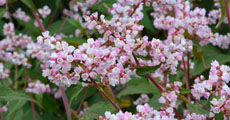 
This gives Susi enough time to stroll around and inspect the surroundings ......
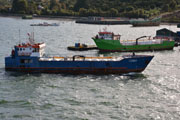

In the area of Puerto Montt salmon farming is a big business.
Naturally salmons grow in freshwater and reach the saltwater (the sea) as adults.
This process has to be simulated when breeding the fish.
The small salmon are breed in freshwater lakes and when the time is ready they are transported in trucks and ships to the farms in the saltwater.
A negative side effect of the salmon farming is that there is far too much food in the sea around the farms.
Krill feeds on this nutritious food
and get too fat.
Whales eat the fat krill, get too fat and get cellulite.
This is not a joke!
 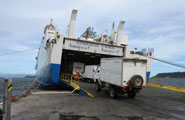
It is obvious that this ferry has only just been added to the Navimag fleet .... not even the name of the shipping company is completely painted on the hull ....
And it is also obvious that the ferry is not new at all.
According to the internet the ferry was built in 1986, sailed first under French flag, was later on sold to Mexico where it was used in the Gulf of California before it was now sold to Navimag in Chile.
Now it sails under the new name "Eden".
The ferry is in bad condition.
It looks as if Navimag realised that they had bought the run-down ferry and instantly started renovating the boat on the way from Mexico to Puerto Montt.
All the security equipment on board is new or freshly maintained and rebranded.
New navigation instruments are installed on the bridge.
In the cabins all carpets are new.
But there is still lots to be done to get the ferry in acceptable condition.
The very friendly crew works around the clock and is constantly busy renovating things and fixing stuff that is broken.
As an example:
At the beginning there are just two toilets in working order for all passengers and the showers are all out of order.
Three days later they have replaced the whole sewage system and all toilets and showers are working order.
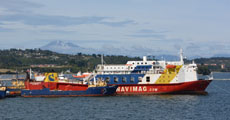
On the peer beside of our ferry the old Navimag ferry "Evangelistas" that used to run on this service can be seen.
Later-on we hear that Navimag lost the license to transport passengers using the old ferry.
There must have been serious issues else the service wouldn't have been stopped from one day to the other without warning and without a replacing ferry ready to take over.
The trip with Navimag from Puerto Montt to Puerto Natales is a mixture between a commercial RoRo transport and a cruise.
Navimag has 2 public relation persons on board.
These guys are always with the passengers and point-out interesting things regarding landscape and wildlife.
They know the areas where the animals normally are and alert the interested.
During the trip there are also 2 slide-shows, one about the local wildlife and one about the fauna and landscape.
The person presenting the shows is on top of things and is able to answer every question.
Through-out the day interesting videos about nature are presented on the new big flat-screens.
The food on board is simple but good and there are always non-alcoholic drinks ready in the dining room for free.
Alcohol can be purchased at the bar.
As said above: The ship is still in a bad state.
The crew still has lots to be done to get it back into acceptable condition.
But it is also very visible that they really do whatever they can and only this makes the situation acceptable for the passengers.

At nightfall we leave Puerto Montt and sail through the Reloncaví Sound and the Golfo de Ancud.
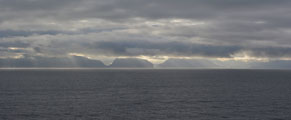
On Saturday morning we are already at the south end of the Golfo Corcovado and can see the first animals ....
 
.... Peale's dolphins.
 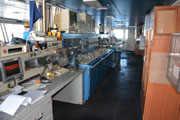 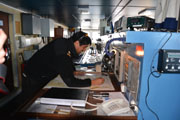
As the weather is quite good and navigation easy passengers are allowed to visit and stay on the bridge.
This is very welcome because the wind is rather fresh.
 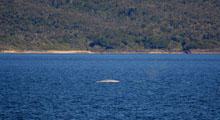 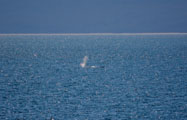 
In the afternoon near Punta Ballena, which is the beginning of the Canal Moraleda, we see Blue Whales and Humboldt Penguins.
It is a known feeding ground for whales.
And that's where all of a sudden the engines stop ......
The crew explains that there is so much krill in the water that it blocks the filters of the engines cooling system.
After cleaning the filters the engines are restarted and the ship can carry on.
We see Isla Melchor at our right continuing direction south.
After a few kilometres the ship makes a sharp 180° turn und drives back in northerly direction.
Then it turns west and passes south of Isla Theresa.
The route originally planned may not be driven at night with the size of Vessel now in use.
Due to the delayed departure in Puerto Montt and the engine-cooling problems we had we are now too late to pass the narrow channels during daytime.
Shortly after entering the channel between Isla Theresa and Isla Melchor the motors have to be stopped again to clean the water filters from krill.
 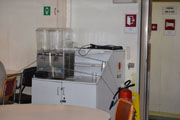
At night we reach the open sea.
The crew prepares the ship for stormy conditions.
Then the going gets a bit rough especially for us as our cabin is at the bow.
Fortunately we are used to that and never the less have a good sleep ..... nothing to write home about.
On Sunday morning we are a bit surprised to see all passengers at breakfast.
But the majority of them have cabins further back towards the middle of the ship so the stomping and rolling of the ship was not felt too much by them.
Still on the open sea but in the coastal area we pass Punta Pringle and Peninsula Tres Montes and then sail through the Golfo de Penas.
There are birds everywhere .....
   
... from Grey-headed Albatrosses to Black-browed Albatrosses to Wandering Albatrosses (Wandering Albatrosses have the largest wingspan of any living bird which is up to 4 meters) ....

... to Southern Giant Petrels ...... they all are large!
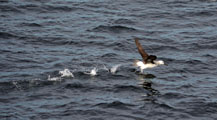
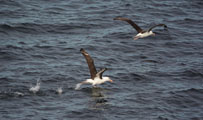
They look funny when they take off from water ....
Click here
 to view the movie.
to view the movie.
 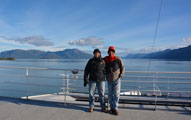
Around noon we leave the open sea and the Golfo de Penas and head to Punta Saliente and the rolling and stomping stops.
The sky turns blue and the views are great.
We sail through the Canal Messier which is up to 1'270 m deep.

It is already late in the afternoon when we reach the point called Bajo Cotopaxy.
In the middle of a rather wide part of the deep Messier Channel we see the wreck of the cargo ship "Captain Leonides".
It is level with the water as if it would still sail.
We are told that what we can see only is the upper wreck of two stranded ships ...... on top of each other!
The lower one is the "Cotopaxi".
It is a curious story and more than one version exists on the Internet ....
On the 15th April 1889 the mail-ship Cotopaxi was proceeding through the Straits at full speed when she ran on the only, but wrongly chartered, sunken rock in deep water.
From the force of the collision the vessel was so damaged that she commenced at once to fill so rapidly as to render the pumps useless.
Her 8 large boats were immediately lowered and the 200 passengers and crew embarked on them.
The Cotopaxi sank ten minutes after the accident with all mails, baggage and cargo.
The ship Captain Leonidas went aground on top of the Cotopaxi when the captain tried to sink it to claim the insurance.
The "sinking" went wrong and he eventually went to prison and lost his captains license for life.
The Captain Leonidas looks much worse as it would look after a simple grounding because the Chilean Army used the wreck as shooting target for quite a while ......
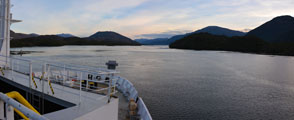 
Shortly after passing the wreck we sail through a sharp and narrow S-bend called “Angostura Inglesa” (English Narrows).
It is impressive how fast our big ferry passes the spot ......
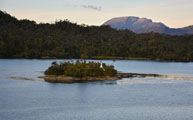
...... which of course is only possible with the help of "Stela Maris" the patron saint of the seafarers who "lives" on a small island nearby .....
At nightfall we reach Puerto Edén, where the last surviving population of the Alacalufe indigenous people in Chile live.
As no roads lead to Puerto Edén they fully depend on the supplies brought by the ferry.
The ferry also acts as "bus service"
to Puerto Natales and is sponsored by the government.
The
locals that catch the ferry stay in the general area and don't have cabins.
On this trip the boat does not even dock at the harbour.
Many small local boats come alongside the ferry to pick up their goods.
Shortly after we carry on.
During the night we sail through the Canal Wide and pass Isla Pigueroa on our left.
Early on Monday morning we pass Isla Chatham.
The weather today is superb again.
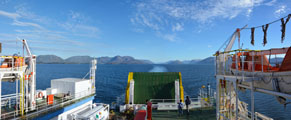

It is a fantastic daytrip through this impressive landscape, not only for us passengers.
The crew also enjoys the journey since they normally pass this stretch at night.
 
The snow-capped mountains look great.
 
The trip takes passed many fjords ...... the snow comes closer and closer ......
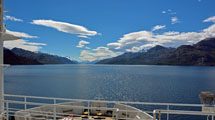 
During the day we sail east of Isla Esperanza, Isla Vancouver and ....
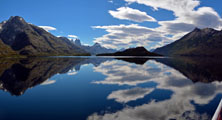 
.... down Estrecho Collingwood.
No - what you see here are not the Torres del Paine .... they cannot be seen from here.
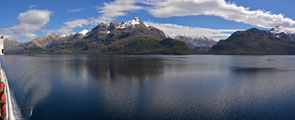
The Cordillera Sarmiento is our most southerly point.
We turn to north-east towards Puerto Natales.
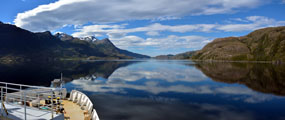 
There is almost no wind, the optimum for mirror pictures.
 
We sail west of Isla Diego Portales and come across the Angostura White (White Narrows), which is only 80 meters wide.
 
Seno Unión (Union Bay) is the last bay before reaching Puerto Natales

In the afternoon of February 24 we arrive in Puerto Natales, a very friendly looking, colourful place.

Looks as if the "Evangelistas" or another ship has hit the peer previously .....
Now things are a bit more complicated because first somebody has to row to the left-overs of the peer and climb onto it to be able to fix the heavy cables that attach the ship.
The unloading of the ship takes a few hours and is as chaotic as the loading was.
The people from Puerto Edén are off in no time ... they know the routine.
But all other passengers have to wait for at least 2 hours until the lower deck has been freed of vehicles.
Then they are allowed off the ship.
We are unlucky because the OKA has a very unfavourable spot and we are unloaded at the very end.
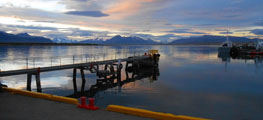
The whole trip was wonderful.
Of course the good weather was an important factor.
We have sailed through very a beautiful landscape and have seen a lot of different animals.
The trip is highly recommended. |
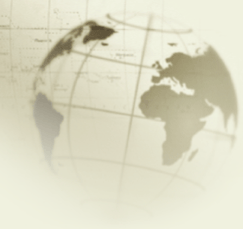
![]() Created by Level X Webdesign
Created by Level X Webdesign